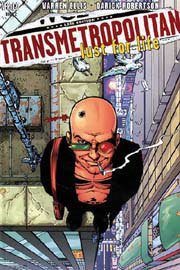
I have 186 books by my bedside waiting to be read. The stacks got so absurd and dangerous a few years ago, that I put up four shelves to hold my eclectic combination of fiction, university press poetry, baseball books, literary classics, history tomes and graphic novels. That wasn't good enough for me. Much to my wife's consternation, I now have three stacks of books, mostly advance reader's copies (free, pre-publication paperbacks that the publishers distribute), piled up beneath the shelves.
Still, I'm not satisfied. Occasionally, I can't find anything that I want to read. When that happens, I hit the slush pile of advance reader's copies (ARCs) at the office. Each month we get shipped about 200 ARCs. It's unwieldy trying to find readers for that many books, and despite the staff''s best efforts, many of the them go unclaimed and unread. These homeless books compose the slush pile.
The best book I ever plucked out of this neglected stash of titles was Zadie Smith's White Teeth. What a surprise and revelation that novel was, with its riotous humor and outrageous characters. Last week, I dipped back into the slush pile, and I pulled out a great debut story collection, Trouble, by Patrick Somerville.
Perhaps, I chose it because of the forlorn adolescent painted on the cover, I was that guy for a good five years. Perhaps, it was the challenge issued on the jacket: "We dare you not to be entertained." Whatever the reason, I soon found myself engrossed in Somerville's stories about guys, young and old, getting into trouble.
Somerville's great sense of humor pervades all of these stories, and this is evident from the very first page of the collection. In the opening story, we get a list of all of the benefits of puberty, including everything from heightened sexual allure due to a deeper voice and a larger penis, to improved basketball dribbling skills and confidence in public speaking. That list sets the tone and gives a framework to all that will follow in the story, from humorous bouts of humilation to misguided bursts of confidence.
Beneath Somerville's humor there is always a sense of foreboding or violence lurking. Characters run into cars with their bikes, they crash into trees while skiing, they get their noses broken playing basketball and some even get killed by the bizarre shadowy deathblow. The combination of humor and violence creates an exhilerating tension in these concise tales.
"If I step back and look at the books as a whole, I can see these violent moments sort of sneaking up and overwhelming the characters....Maybe it's because I'm a young writer, but I can never fully resist the urge to give the characters what they deserve -- to punish them, or to dangle their temptations in front of them and allow them to do whatever," Somerville wrote in an email interview.
The collection's finest story, "Black Earth, Early Winter Morning", breaks the pattern a bit. There is a violent accident (two, actually), but unlike many of the stories, the humor doesn't overwhelm the characters and their tragedies. It is a thoughtful, almost meditative, piece about physical loss and also the loss of expectations. That's not to say there aren't funny moments in the story. On the contrary, the bumbling teenage boy tries to make out with a college girl moments after she's vomited. Sure it's gross, but what a perfect encapsulation of an adolscent boy's sexuality.
When I asked Somerville about the humor in his stories, he pointed to "Black Earth, Early Winter Morning" as a conscious break from the rest of the collection. "Sometimes the story should just be really sad.... 'Black Earth, Early Winter Morning' was the last story I wrote, and it is by far the most tragic. I told myself beforehand that I would not make it funny, would not get wacky, would not try to achieve any of that balance."
Trouble is a wonderful book and I also dare anyone to read it and not be entertained. My only regret is that it is Somerville's debut. There isn't any more of his pithy humor and accident-prone characters to amuse me. So, it is back to the slush pile for me, since none of the 186 books in the bedroom is capturing my imagination. Just don't tell my wife, or I'll also be in trouble.
Interview:
Kash's Book Corner (KBC): Trouble is certainly an apt title for this collection. Your characters have all kinds of difficulties; one character smashes into a tree while skiing, another crashes his bike into the same car twice, a 57-year old doctor has an affair with a teenager. Do you think of an entertaining accident or disaster first and build a story around it? Or do you start with a seemingly normal character and then they find trouble?
Somerville: I think the latter is probably more accuarate, at least relative to the stories in the collection. If I step back and look at the book as a whole, I can see these violent moments sort of sneaking up and overwhelming the characters, and what's more, I can see, now, what it meant to me then, what I was trying to do. Usually it's something blatant and not-too-subtle. Maybe it's because I'm a young writer, but I can never fully resist the urge to give the characters what they deserve--to punish them, or to dangle their temptations in front of them and allow them to do whatever. I admit that there are probably a million better, more aesthetically-interesting possibilities, but this is what I'm doing now. I also love slapstick humor. Having a character trip gives me way too much pleasure.
KBC: Violence, whether in the guise of grisly accidents or shadowy deathblows, haunts these stories. Can you speak about its role in your work?
Somerville: I wouldn't even say that I'm very interested in violence--it just tends to end up in my stories, usually in the form of accidents. So many of the characters in the book think they can control life by being smart. Accidents are the antidote to that disease.
KBC: Most of the characters lead emotionally isolated lives, is that just a condition of men in our society or do you have a unique bunch of guys here?
Somerville: I'm in no position to make claims about men, or most men, in our society. What can I say? Some yes and some no. I'm certainly interested in writing about people who lead emotionally isolated lives, but whether or not it's a widespread problem is something I just don't know. In my own experience, I usually find it much harder to communicate with men than with women. With men, there's often this whole added level of defenses--guarded appraisals, comparisons, macho stuff. All of it is incredibly boring, and usually takes up so much time that you've both already gone home to sleep before you're anywhere near actually knowing one another.
KBC: I can't tell you how many times I laughed out loud when reading these stories, especially "English Cousin." Does the humor come naturally to you or is it something that needs as much or more revising as the other aspects of the writing?
Somerville: Quote unquote humor is something that is built into the way I write, definitely, but whether or not it's actually funny when it first comes out is another story. Usually I'll try too hard at first, and it will be totally over-the-top. There used to be this complicated masturbation scene in "Crow Moon" that went on for 4 or 5 pages and involved photo developing. Maybe there was enough to it for some chuckles, but in the long run, it seemed to hurt the story more than help it, especially because that story is pretty heavy compared to some of the others. I have an impulse for balance, as though tragic moments need to be balanced by comic moments, but as time goes on I'm realizing that this formula can get very repetitive, and is also limiting. Sometimes the story should just be really sad. Sometimes the opposite. "Black Earth, Early Winter Morning" was the last story I wrote, and it is by far the most tragic. I told myself beforehand that I would not make it funny, would not get wacky, would not try to achieve any of that balance. In the end, it's turned out to be one of my favorites. Sort of a downer at readings, though.
KBC: Where did you come up with Dan Oxford swallowing coins in the story "The Future, the Future, the Future"? Seems like a bad idea.
Somerville: You mean a bad idea for the story or a bad idea in real life? Isn't this supposed to be a nonconfrontational Q&A? No, I'm assuming you mean bad in real life. I definitely didn't eat any coins to do research for this one. I do remember, though, walking home in Ithaca one day and looking at garbage and thinking about how garbage is a completely different thing to the rich, and it can be virtually anything. I imagined a rich guy standing next to a trash can, dropping hundred dollar bills into it, and then I imagined him eating them and laughing. For the last five minutes of the walk, I just tried to think about how I could use money-eating in the story, which I'd just begun. Coins has already been established as an interesting little node, but I didn't know how, exactly, I was going to use them later in the story. I ended up with Dan eating coins whenever he feels as though his life isn't working properly, as a way of venting. He's a character who connects happiness to money over and over again, and who sees both things as down the road, in the future. So his meltdown moments involve him revolting against his big plans. I agree, it's very strange. But I like strange.
KBC: Your characters have great, culturally relevant names like Gidget, Garfield, Oxford -- how and why do you use these in your stories?
Somerville: I have no idea. The names just come into my head and I ask myself, "Can I actually use that?" Usually the answer is yes, because why not? It's better than using Tristan.
KBC: Trouble is out as a paperback original, which is great because it's more affordable, but it is often harder to get review attention in this format, unless you are Jhumpa Lahiri or David Mitchell. Did you have any qualms about going straight to paperback?
Somerville: None at all. It's an affordable book for young people, and I think young people are its best hope. Also, it's not a long book...who wants to pay $25 for 200 pages?
KBC: Are you on tour? Where are you going?
Somerville: I am on tour, and have already been to the west coast. I'll be heading to Boston and New York next week, and after that, a lot of midwest. You can see the details at www.patricksomerville.com/tour.htm
KBC: What's next? Will you stick with stories or do you have a novel hidden somewhere?
Somerville: I'm working on a novel.


















